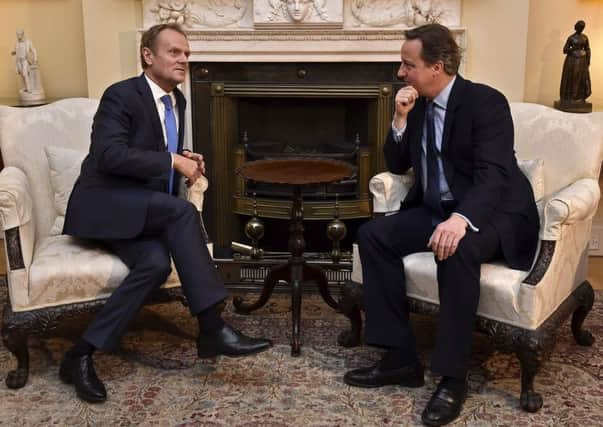Cameron's EU deal set to be published


European Council president Donald Tusk is expected to set out the proposed solutions to the UK’s demands for change in a letter to EU leaders on Tuesday ahead of a summit later this month.
Writing on Twitter tonight, Mr Tusk said there had been “good progress” since his Downing Street talks with the Prime Minister on Sunday “but still outstanding issues”.
Advertisement
Hide AdAdvertisement
Hide AdHe expected to publish the proposals “around noon” on Tuesday.
While pro-Europe and Eurosceptic groups have been setting out their case for months, the publication of the draft deal will add significant substance to the debate.
And it will force those politicians who have adopted a wait-and-see stance to begin to declare their hand.
New research suggests a fifth of the Prime Minister’s own MPs will vote to leave regardless of the deal struck but more than half are open to persuasion either way.
Advertisement
Hide AdAdvertisement
Hide AdA letter from Mr Tusk tomorrow would keep the process on track for the referendum on Britain’s membership of the EU to be held in late June.
Leave campaign groups today moved to pre-empt any attempt by Mr Cameron to claim victory with the outcome of his negotiations.
Matthew Elliott, chief executive of the Vote Leave campaign, said: “The final outcome of these negotiations will be a set of deeply trivial reforms that won’t bring powers back from Brussels.
“Even with the avalanche of spin that will accompany the final deal, the renegotiation won’t take back control for the British public. The only way to do that is to Vote Leave.”
Advertisement
Hide AdAdvertisement
Hide AdToday saw intensive negotiations continue over the concerns on migration, sovereignty, competitiveness and protection for non-eurozone countries where Mr Cameron has demanded change in EU rules.
Downing Street said the PM had secured a significant assurance that a proposed “emergency brake” on welfare payments to EU workers could be triggered immediately after a vote to remain in the EU, on the basis of existing levels of immigration.
Mr Cameron’s official spokeswoman insisted that Britain had made “substantial progress”, but added: “There is more work to do in all four areas - more work in some areas than in others.”
She told a regular Westminster media briefing: “There is more hard work to be done both in terms of the proposals that are tabled and how far they go in addressing the reforms we are seeking, but then - let’s be clear - in the run-up to either the February European Council or whenever we get a deal, there will be a lot of hard work to get 27 other member states signed up to what we need.
“There is a lot still to do.”
Advertisement
Hide AdAdvertisement
Hide AdIt remained unclear how the proposed emergency brake would operate and who would have the final say on when the measure could be activated and how long it would remain in effect.
The mechanism has been put forward by Brussels as an alternative to Mr Cameron’s plan to impose a unilateral four-year curb which other member states ruled out as discriminatory and in breach of the freedom of movement principle.
The PM agreed to accept it as a “stop-gap” measure - on the condition he received assurances the existing pressure on the UK would meet the threshold to trigger it and it could remain in place.
One critical stumbling block is the UK’s demand for it to be allowed to remain in place “long enough to resolve the underlying problem” - perhaps as long as seven years.
Advertisement
Hide AdAdvertisement
Hide AdEU leaders are due to meet on February 18 and 19 where the final deal to be put to the British people should be agreed.
June 23 is emerging as the most likely referendum date. Eurosceptics are calling for a longer campaign.